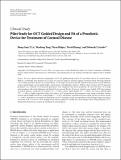| dc.contributor.author | Le, Hong-Gam T. | |
| dc.contributor.author | Tang, Maolong | |
| dc.contributor.author | Ridges, Ryan | |
| dc.contributor.author | Huang, David | |
| dc.contributor.author | Jacobs, Deborah Sue | |
| dc.date.accessioned | 2013-05-09T13:15:55Z | |
| dc.date.issued | 2012 | |
| dc.identifier.citation | Le, Hong-Gam T., Maolong Tang, Ryan Ridges, David Huang, and Deborah Sue Jacobs. 2012. Pilot study for OCT guided design and fit of a prosthetic device for treatment of corneal disease. Journal of Ophthalmology 2012:812034. | en_US |
| dc.identifier.issn | 2090-004X | en_US |
| dc.identifier.issn | 2090-0058 | en_US |
| dc.identifier.uri | http://nrs.harvard.edu/urn-3:HUL.InstRepos:10612913 | |
| dc.description.abstract | Purpose: To assess optical coherence tomography (OCT) for guiding design and fit of a prosthetic device for corneal disease. Methods: A prototype time domain OCT scanner was used to image the anterior segment of patients fitted with large diameter (18.5–20 mm) prosthetic devices for corneal disease. OCT images were processed and analyzed to characterize corneal diameter, corneal sagittal height, scleral sagittal height, scleral toricity, and alignment of device. Within-subject variance of OCT-measured parameters was evaluated. OCT-measured parameters were compared with device parameters for each eye fitted. OCT image correspondence with ocular alignment and clinical fit was assessed. Results: Six eyes in 5 patients were studied. OCT measurement of corneal diameter (coefficient of variation, CV = 0.76%), cornea sagittal height (CV = 2.06%), and scleral sagittal height (CV = 3.39%) is highly repeatable within each subject. OCT image-derived measurements reveal strong correlation between corneal sagittal height and device corneal height (r = 0.975) and modest correlation between scleral and on-eye device toricity (r = 0.581). Qualitative assessment of a fitted device on OCT montages reveals correspondence with slit lamp images and clinical assessment of fit. Conclusions: OCT imaging of the anterior segment is suitable for custom design and fit of large diameter (18.5–20 mm) prosthetic devices used in the treatment of corneal disease. | en_US |
| dc.language.iso | en_US | en_US |
| dc.publisher | Hindawi Publishing Corporation | en_US |
| dc.relation.isversionof | doi:10.1155/2012/812034 | en_US |
| dc.relation.hasversion | http://www.ncbi.nlm.nih.gov/pmc/articles/PMC3536438/pdf/ | en_US |
| dash.license | LAA | |
| dc.title | Pilot Study for OCT Guided Design and Fit of a Prosthetic Device for Treatment of Corneal Disease | en_US |
| dc.type | Journal Article | en_US |
| dc.description.version | Version of Record | en_US |
| dc.relation.journal | Journal of Ophthalmology | en_US |
| dash.depositing.author | Jacobs, Deborah Sue | |
| dc.date.available | 2013-05-09T13:15:55Z | |
| dc.identifier.doi | 10.1155/2012/812034 | * |
| dash.contributor.affiliated | Jacobs, Deborah | |


